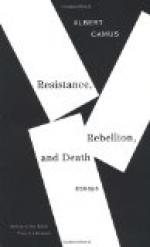Maurice Maeterlinck has always remained very conscious of that door. How often in his whispering dramas we are made aware of it! How often, without even the knock of warning, it suddenly gapes or stands ajar, and unseen hands are pulling, and children are drawn in, and young girls are drawn in, and wise men, and the old, while the living world remains outside, still at breakfast, still busy with its evening games and sewing, still blindly groping for its departed guide! From the outset, Maeterlinck has been an amateur of death. In a little volume that bears Death’s name, he utters his meditation upon death’s nature and significance. Like other philosophers and all old wives, he also attempts our consolation. Mankind demands a consolation, for without it, perhaps, the species could hardly have survived their foreknowledge of the end. But in treating the first two terrors to which he applies his comfortable arguments, Maeterlinck’s reasoning appears to me almost irrelevant, almost obsolete. He attributes the terrified apprehension of death, first, to the fear of pain in dying, and, secondly, to the fear of anguish hereafter. In neither fear, I think, does the essential horror of death now lie. All who have witnessed various forms of death, whether on the field or in the sick chamber, will agree that the process of dying is seldom more difficult or more painful than taking off one’s clothes. The blood ebbs, the senses sleep, “the casement slowly grows a glimmering square,” breath gradually fails, unconsciousness faints into deeper unconsciousness, and that is all. Even in terrible wounds and cases of extreme pain, medicine can now alleviate the worst, nor, in any case, do I believe that the expectation of physical agony, however severe, has much share in the instinct that stands aghast at death. If fear of pain thus preoccupied the soul, martyrs would not have sown the Church, nor would births continue.
In combating the dread of future torment, Maeterlinck may have better cause for giving comfort. Long generations have been haunted by that terror. “Ay, but to die,” cries Claudio in Measure for Measure:




